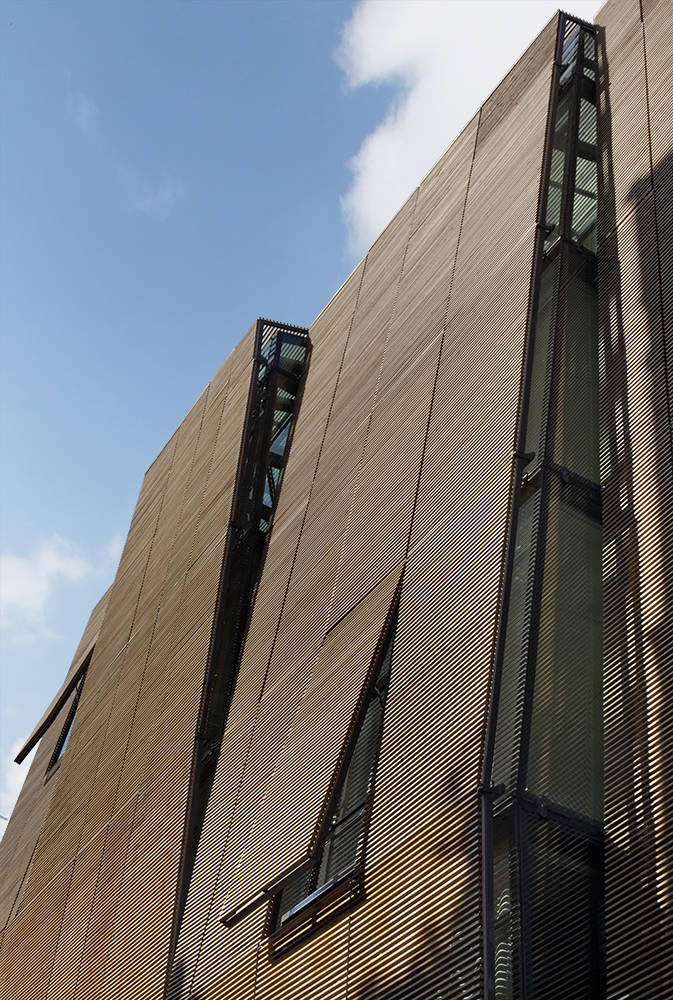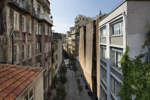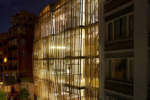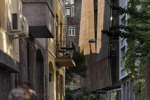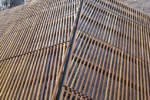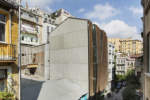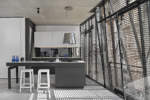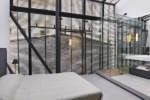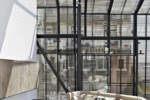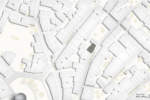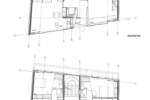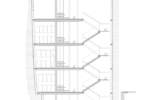architect: Alatas Architecture and Consulting
location: Istanbul, Turkey
year: 2012
The building is located on Tatarbeyi Sokak, is one of the most virginal and underdeveloped streets of the rapidly transforming Galata District under conservation. Comprised of eight 80 sqm studio flats and one 190 sqm penthouse up for sale, it has a total surface area of 1000 sqm. The building is a residential project that extends beyond the conventional codes of the already-built environment, yet manages to reproduce these codes, respecting the existing architectural fabric. In this regard, it continues to find new solutions to the existing problems of architecture by utilizing contemporary technologies and taking into consideration the newly burgeoning socio-economic structure of the region, as well as the infrastructure, environmental conditions, climate, and solar movements.
The building is comprised of a wooden shell that covers the largely transparent living area in an uncompromising manner and set between two blind and extremely thing exposed concrete curtain walls. The wooden components on the front elevation run parallel to the glass façade that evolves into a saddle rood and entirely cover the front and back of the building. Perceived as a gigantic blind façade from one perspective, yet appearing as a translucent veil from the other, the wooden surface also functions as a sun filter.
Comprised of parallel horizontal laths that angle at various points, the wooden element divides the façade into four as the middle segments expand outwards, towards the street; leaving the sides exposed, the wooden elements thus allow a view of the street and create a bay window effect that establishes a link between home life and life on the street. While the building almost disregards the relationship with the street by refusing to repeat the conventional window spans in the neighborhood, it nonetheless revives its place within the context by reinterpreting the traditional bay window structure on the street. Behind its impressive presence on the street, the building displays a plain and statuesque appearance that simultaneously blends into and stands out against the context without competing with the neighboring historic buildings in its critical approach.
As the design is concretized, the concept of the transparent surface of the wooden veil covering the two façades and the roof between two walls is maintained throughout without any qualms.
The dilapidated appearance of the neighboring building at arm’s length is perceived as part of the view and the transparent surface is not even partially compromised.
While this attitude and the spatial relationship of the interior and the exterior expands the interior volumes of the 80 sqm flats – born out of the new lifestyle needs and culture – towards the façade of the buildings across the street, the translucent nature of the building’s shell allows the street to feel broader and more spacious.
The building constitutes the first example if its kind in demonstrating that conservation in the historic Galata District can be achieved successfully not merely by preserving and replicating the past.
By extension, this approach has elicited positive responses from the city and thus blazed a trail in its own right. The building gave impetus and a positive direction to the ongoing urban transformation at a stagnant and underdeveloped point in Galata.
In transforming an idea into a building, Alataş’ architectural stance, his light design, use of natural energy sources, and attempt to create readable structures, as well as the unconstrained, flexible, boundless, and transparent character of his designs are reflected everywhere from the connection details of the components to the relationship between the building and its setting.
Completed in 2011, a number of the flats in the building are used as dwellings by artists and foreigners that prefer to live in this neighborhood. Others, on the other hand, are rented out to short-term visitors of the city.
The neighboring structures adjoin the building on all three sides on the sloped terrain with difficult working conditions. In order to avoid any possible damage to these structure, the building’s raft foundation and curtain walls were thus completed by using the hand-dug well foundation technique in stages. In a city center where land is precious, the exposed concrete curtain walls and concrete floors isolating the building from its neighbors were poured in an extremely thin manner, resembling fire walls of the past. It was thus possible to use such a thin layer of concrete in a load-bearing system where concrete and steel were integrated and the structural elements functioned with vertical loads without receiving any momentum. In line with the needs of the structural system, the connection details of steel and concrete and the location and shape of the diagonal steel sets against lateral forces were specially designed by an architect.
Instead of repeating the load bearing systems used frequently in this geography, this approach not only advanced the details but also introduced an innovative touch to the building’s architecture.
Cradled in steel and concrete and used uninterruptedly in the front and rear elevations, the structural glass façade pursues patent architecture that produces new details rather than succumbing to assembly architecture with familiar systems. The non-profiled sliding wings manufactured specifically for the façade and façade cover joints are produced with unique details that are not revealed at first glance.
The concept of the transparent surface of wooden veil covering the two façades and the roof between two walls was developed specifically for this building by the architect himself. The concept was achieved by elegantly suspending the steel and wooden elements from the points holding the glass panes of the façade.
In the double-façade flats facing the east and the west, the temperature difference emerging between the façades at various hours of the day is designed to provide natural horizontal air conditioning. While the moveable shell covering the outer façade protects the glass façades against daylight and heat in the summer, the 20-cm void between the building and its exterior creates a chimney effect and generates a natural air circulation around the building. In winter, on the other hand, sunlight permeating through the moveable shell is stored as heat on the exposed concrete surfaces of the floor and walls, thereby providing heat conservation for the building and its dwellers.


